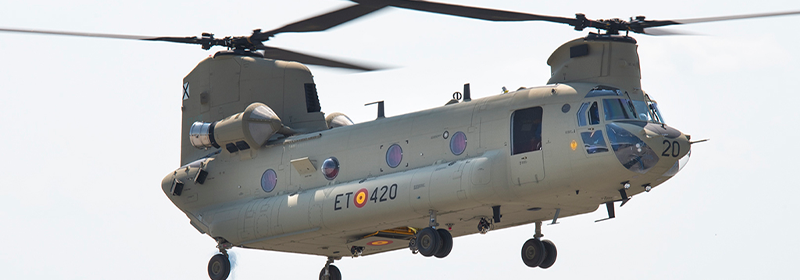- It will supply its Talium mission system, capable of planning, optimizing and conducting operations with great agility and efficiency, thus automating multiple tasks, reducing the likelihood of errors and covering the logistics maintenance
- The contract, awarded by the Directorate General of Armaments and Material (DGAM) for 15 million euros, will boost benefits in join missions with the Spanish NH90 and Tigre helicopters, which are already using the system in real operation with excellent result
- With this contract, Indra reinforces its leadership in the development of a new generation of planning systems for aerial platforms that are fully integrated into command and control. The company is also coordinating the development of Europe’s future strategic command and control system (ESC2) and developing air defence systems for armies around the world

Indra will supply the CH-47F Chinook helicopters of the Spanish Army’s Airmobile Force (FAMET) with Talium, one of the most advanced mission planning systems currently in existence, designed to greatly increase the efficiency and safety of helicopters operating in complex scenarios. The contract totaling 15 million euros has been awarded to Indra by the DGAM (Directorate General of Armaments and Material).
Mastery of information leads to a decisive advantage over the adversary and reduces uncertainty during operations. Talium can easily manage huge data volumes to plan and conduct missions in increasingly uncertain environments.
In operational terms, the system supports the decision-making by helping to determine the units, resources and logistical support required to carry out the operation, regardless of its size and complexity. It also sequences the actions to complete and defines the hierarchical structure.
On a tactical level, it analyzes the flight plan defined by the user and the potential threats the aircraft may encounter, optimizing the configuration of key logistical and tactical aspects related to the helicopter’s load, electronic defence and navigation, cabin configuration and fuel and helping the commanders determine the feasibility of the mission. The system can even calculate the flight profile to be followed to prevent attacks and facilitate the communications plan by choosing the frequencies, coverages and types of links to be used.
Talium is ready to be installed in different configurations at command and control centers and centers deployed in the field. Its most basic functions can also be controlled via a rudimentary computer or the aircraft’s own mission system. Once the ground planning has been completed, the data are uploaded onto the aircraft, which is then ready to fly.
When the mission is executed, depending on the availability of the data link, the system permits the aircraft to exchange real-time critical data with the command center and other allied platforms, thus contributing to maintaining an updated operational picture and reinforcing the coordination and safety of all the participants.
The solution can also be integrated into the BMS (battlefield management system), national and NATO command and control systems, air defence systems, IFF and simulators. Spanish Tiger and NH90 helicopters already use this advanced Indra system, which has demonstrated top-level capabilities in conflict zones. Its integration into the Chinook CH47F will multiply the benefits when it comes to managing joint and multi-platform missions. Talium is a scalable and modular solution that can evolve to integrate new platforms and become a unified system for the joint operation of the entire fleet.
According to Raúl Pajarín, Indra’s Airborne Platforms Director, “the implementation of Talium constitutes a huge leap forward in the Army’s digitization. Beyond the aircraft’s characteristics, it will be its intelligence capacity to prepare and conduct missions, as well as the capacity to operate in a network, exchanging data and information with the rest of the force, which will endow it with the superiority in the field that it needs.”
The implementation of Talium represents a huge leap forward in the digitization of the Army. Beyond the characteristics of the aircraft, it will be the intelligent capacity to prepare and conduct missions, as well as the network operation, exchanging data and information with the rest of the force, which will provide it with the superiority on the ground it needs.”
Logistics 4.0 to stay ahead of requirements
Talium goes far beyond the capabilities of traditional mission systems, as it has been developed to cover the comprehensive management of the entire operation.
To do so, it incorporates logistics 4.0 capabilities enabling it to process and analyze high volumes of data downloaded from the platform so as to monitor its health status and in-flight performance. The management of these processes significantly reduces the logistics footprint by streamlining the deployment of the aircraft anywhere on the planet.
With this contract, Indra will reinforce its leadership of the development of the new generation of command and control systems. It currently leads the development of the future European strategic command and control system (ESC2), which will coordinate the joint military operations of member countries, while it has also implemented anti-aircraft command defence systems and battlefield management systems.
About Indra
Indra (www.indracompany.com) is one of the leading global technology and consulting companies and the technological partner for core business operations of its customers worldwide. It is a world-leader in providing proprietary solutions in specific segments in Transport and Defence markets, and a leading firm in Digital Transformation and Information Technologies in Spain and Latin America through its affiliate Minsait. Its business model is based on a comprehensive range of proprietary products, with a high-value, end-to-end focus and with a high innovation component. In the 2021 financial year, Indra achieved revenue totaling €3,390 billion, more than 52,000 employees, a local presence in 46 countries and business operations in over 140 countries.